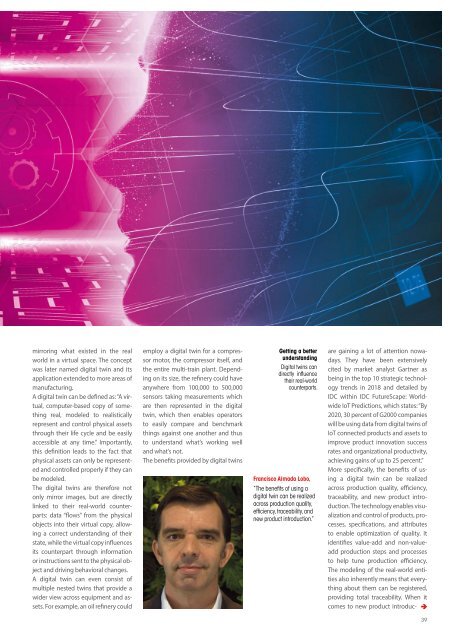Smart Industry 2/2018
Smart Industry 2/2018 - The IoT Business Magazine - powered by Avnet Silica
Smart Industry 2/2018 - The IoT Business Magazine - powered by Avnet Silica
Create successful ePaper yourself
Turn your PDF publications into a flip-book with our unique Google optimized e-Paper software.
mirroring what existed in the real<br />
world in a virtual space. The concept<br />
was later named digital twin and its<br />
application extended to more areas of<br />
manufacturing.<br />
A digital twin can be defined as: “A virtual,<br />
computer-based copy of something<br />
real, modeled to realistically<br />
represent and control physical assets<br />
through their life cycle and be easily<br />
accessible at any time.” Importantly,<br />
this definition leads to the fact that<br />
physical assets can only be represented<br />
and controlled properly if they can<br />
be modeled.<br />
The digital twins are therefore not<br />
only mirror images, but are directly<br />
linked to their real-world counterparts:<br />
data “flows” from the physical<br />
objects into their virtual copy, allowing<br />
a correct understanding of their<br />
state, while the virtual copy influences<br />
its counterpart through information<br />
or instructions sent to the physical object<br />
and driving behavioral changes.<br />
A digital twin can even consist of<br />
multiple nested twins that provide a<br />
wider view across equipment and assets.<br />
For example, an oil refinery could<br />
employ a digital twin for a compressor<br />
motor, the compressor itself, and<br />
the entire multi-train plant. Depending<br />
on its size, the refinery could have<br />
anywhere from 100,000 to 500,000<br />
sensors taking measurements which<br />
are then represented in the digital<br />
twin, which then enables operators<br />
to easily compare and benchmark<br />
things against one another and thus<br />
to understand what’s working well<br />
and what’s not.<br />
The benefits provided by digital twins<br />
Getting a better<br />
understanding<br />
Digital twins can<br />
directly influence<br />
their real-world<br />
counterparts.<br />
Francisco Almada Lobo,<br />
“The benefits of using a<br />
digital twin can be realized<br />
across production quality,<br />
efficiency, traceability, and<br />
new product introduction.”<br />
are gaining a lot of attention nowadays.<br />
They have been extensively<br />
cited by market analyst Gartner as<br />
being in the top 10 strategic technology<br />
trends in <strong>2018</strong> and detailed by<br />
IDC within IDC FutureScape: Worldwide<br />
IoT Predictions, which states: “By<br />
2020, 30 percent of G2000 companies<br />
will be using data from digital twins of<br />
IoT connected products and assets to<br />
improve product innovation success<br />
rates and organizational productivity,<br />
achieving gains of up to 25 percent.”<br />
More specifically, the benefits of using<br />
a digital twin can be realized<br />
across production quality, efficiency,<br />
traceability, and new product introduction.<br />
The technology enables visualization<br />
and control of products, processes,<br />
specifications, and attributes<br />
to enable optimization of quality. It<br />
identifies value-add and non-valueadd<br />
production steps and processes<br />
to help tune production efficiency.<br />
The modeling of the real-world entities<br />
also inherently means that everything<br />
about them can be registered,<br />
providing total traceability. When it<br />
comes to new product introduc-<br />
39
















